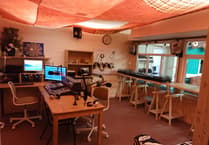Dartmouth historian and Vice chair of Dartmouth Museum Jonathan Turner was researching a project for the Devon History Society’s 1920s project, when he came across this photograph of the Dart Jazz Band, from around 1929.
It prompted him and a team of Dartmothians to create a unique event at the Flavel Arts Centre on July 12 that will feature a recreation of the Dart Jazz Band playing songs from the 1920s, with dancers strutting their steps to the Charleston, Shim Sham and Big Apple!
As part of the research into the decade, and in preparation for the event, the team would like to hear from anyone related to any of the band members, or who is familiar with the Dart Jazz Band.
From left to right:
Oscar Hutchins was 45 in 1929 and the leader of the band, having been trained as a military bandsman since he was 11, and now serving at BRNC.
His son Harold Hutchins was an excellent photographer and involved with the Dartmouth Museum.
Although Oscar is pictured with a cello here, he would have played many other instruments in the BRNC band, and also the Borough or Town Band.
The other members of the Dart Jazz Band were young men 15-20 years younger than Oscar.
Two of the band were step brothers: Frank Carder, the drummer was only 19 in 1929, and was training to be a hairdresser in his mother’s tobacconist and hairdressers at No. 8 Foss Street.
His mother had a child, Harry Caunter, from a previous marriage, and he was was 23 in 1929 and the singer of the band; he too was an assistant hairdresser and lived above the shop in Foss Street. The other two band members both worked at Philips shipyard at Noss.
Albert Tabb was 26 and a Plater’s Mate at Philips, played the banjo, while Jim Hebditch played saxophone and other wind instruments, and also worked at Philips, possibly as a pneumatic driller.
The band played at the Dartmouth Subscription Rooms for Clubs and Societies at Christmas and the New Year; for Hunt Balls and Sports Club Dances too.
Jim married the local dance teacher Rita Bunday who ran a dance school in the girls school.
They produced shows and dances at the Subscription Rooms, raising money for, amongst other causes, Distressed Miners, after the 1926 strike.
They would love to hear from anyone with any further information on the Dart Jazz Band and its players.
If you have any information, clippings, programmes, or photos, please contact Jonathan Turner at: [email protected]
The 1920s was also known as the ‘Jazz Age’ and saw jazz music and dance styles gain worldwide popularity, with the United States, its birthplace, experiencing significant cultural repercussions.
Jazz was very popular until the 1950s and 1960s when rock and pop gained increasing favour with masses but is now making a comeback with groups such as the Ezra Collective who this year became the first jazz band to win the Group of the Year accolade at the Brit Awards.




